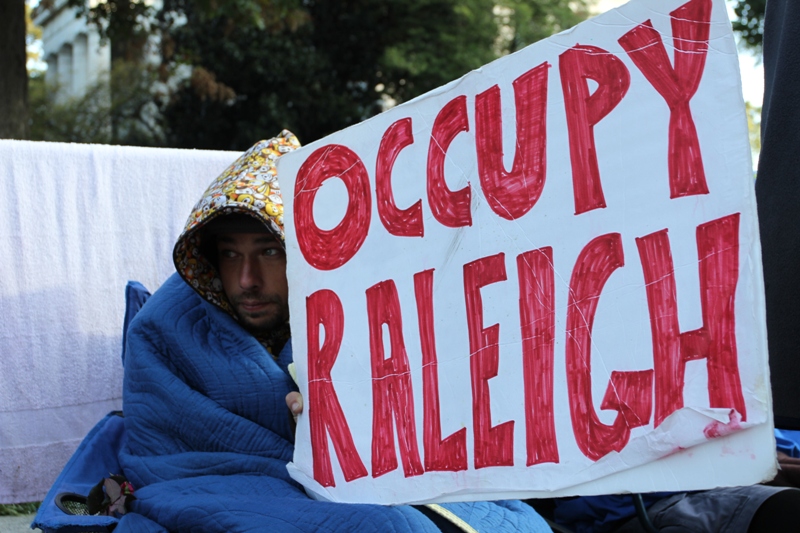Just under a dozen Occupy Raleigh protesters braced themselves early Thursday morning against the chill in front of barricades surrounding the State Capitol, days after the first protest led to the arrests of 19 people.
Occupy Raleigh’s first rally Saturday consisted of soapbox speeches, signs such as “I won’t believe corporations are people until Texas executes one” and energized marches down Fayetteville Street.
But, that was just the beginning. Tuesday night, a group of about 20 people continued to stand outside the Capitol. About a dozen remained on the sidewalk even as temperatures dropped overnight Wednesday.
They are not permitted on the state-owned park around the Capitol, but the sidewalk is city property.
Eddy Samara, one of the protesters arrested Saturday, said it’s “an ongoing occupation.”

An Occupy Raleigh protester wraps up to keep warm Thursday. Photo by Will Huntsberry.
Seeds of Occupancy
Occupy Raleigh began as a Facebook page and has, at last check, more than 4,600 “likes.”
Stacie Borrello, who started the Facebook page, said Occupy Raleigh is a “group of concerned citizens” who are aligned with the national Occupy movement and whose chief concern is economic justice.
Borrello said the local movement got started because people here “saw [Occupy Wall Street] happening and they were waiting for something to come up in [Raleigh.]”
The Facebook page led to boots on the ground. The first general assembly was planned and people started self-organizing.
“The word’s getting out, and people are finding out about it in ways other than the Facebook page,” Borrello said.
The discussion on Twitter is constant using the hashtag #occupyraleigh.
Finding its Voice
The aim of Occupy Raleigh “depends on who you ask,” said occupier Erik Johnson.
For many of the protestors, eliminating corporate personhood, taxing all income (such as corporate profits) as ordinary income and putting a moratorium on foreclosures are just a few of the top priorities.
For Johnson the goal is much broader.
“If you ask me, the most important thing that can happen here is that people who are feeling frustrated and want to do something about it do get involved in direct action because it is so broadening,” he said.
Many protestors say the movement transcends the notion of political parties.
“This isn’t a Democratic Party movement; this is a people’s movement,” Borello said.
But so far it’s a movement that hasn’t agreed on a list of demands, which Borello attributes to the lengthy process of achieving consensus.
Leaderless Occupation
The movement is structured through a “democratic process, where there’s no kind of C.E.O. or executive that says ‘This is how we’re doing it,’” Borello said.
“People have equal voices and have the opportunity to object to things or to put forward new ideas,” she said.
But that means everything comes to a vote, which can lead to frustration and confusion.
Occupy Raleigh voted during an Oct. 9 general assembly meeting to align itself with the Occupy Wall Street movement, prompting some to walk out frustrated with the process.
George Gulino, another protester, expressed doubts about the group remaining leaderless.
“We got here. They said there was no leader, but now there seems to be a golden circle,” he said.
But, 27-year-old Will Carroll said he believes the leaderless framework is effective.
When asked if getting things done is harder, he said, “surprisingly no.”
“At first, there was a little bit of confusion at the first couple of assemblies, but now that everybody understands the process, it’s kind of gone a lot more smoothly,” Carroll said.
Mary Stephenson, 41, who’s been unemployed since April 2009 added, “We do argue. We need to get better at that.”
Erik Johnson said the confusion in process doesn’t make the group disjointed.
“This guy has different goals from me. We obviously share some goals because we’re both out here, but we don’t want exactly the same thing,” he said. “We want two different lives because we’re two different people. We just happen to believe that we could maybe live those lives better by joining together and working in solidarity to accomplish goals.”

The crowd marched past the Bank of America building on Fayetteville St. in downtown Raleigh. Photo by Karen Tam.
What’s Next
“For right now, the plan is that we will stay here,” said Eddy Samara, pointing to their line of chairs and supplies on the Morgan Street sidewalk.
“We were here last night [Sunday] even though they continued to make us stand and be awake,” he said. “People continued to occupy here and on the other sidewalk, and the plan is to continue to stay here tonight and be here in the morning.”
Samara believes Occupy Raleigh members will continue to march on banks and “send the message that it’s not okay to bail out the banks when people are being asked to be subject to austerity measures, and this is really inhumane.”
When asked if they were planning more civil disobedience, Samara and Josh Harris, another of those arrested, said not at this time.
“To have 19 people arrested on the Capitol grounds in one action is pretty amazing to me,” Samara said.
“We want to see what the ripple effect will be,” added Harris, a former financial advisor.
Those in the group mentioned plans of parking deck sit-ins, appeals to legislators, newsletters and a general education plan, but for now Occupy Raleigh remains a dedicated few clinging to the sidewalk outside the old State Capitol.
The group doesn’t “have too much of a what’s next plan, unfortunately” said occupier Harrison Savage. “I think it’s really more of a regrouping period.”
Will Huntsberry and Chris Cioffi contributed to this report.
